The Spix Macaw, also popular as the little blue macaw, is a captivating and highly endangered parrot species that has captivated the world with its striking beauty and remarkable story. Native to the arid regions of northeastern Brazil, this elusive bird, with its vibrant blue feathers and distinct features, has become an emblem of hope and a symbol of the challenges faced by endangered species in the modern world.
Unfortunately, the Blue Spix Macaw is on the brink of extinction, primarily because of habitat loss and illegal wildlife trade. However, amidst the grim reality, there is a glimmer of hope. Conservation efforts, breeding programs, and collaborative initiatives have been launched to safeguard this magnificent species from the brink of oblivion.
In this article, we will delve into the world of the Spix Macaw, exploring its history, unique characteristics, lifespan, this macaw parrot price, the potential future for this iconic bird, and another related topic that needs to understand for this Brazilian bird warfare.
History
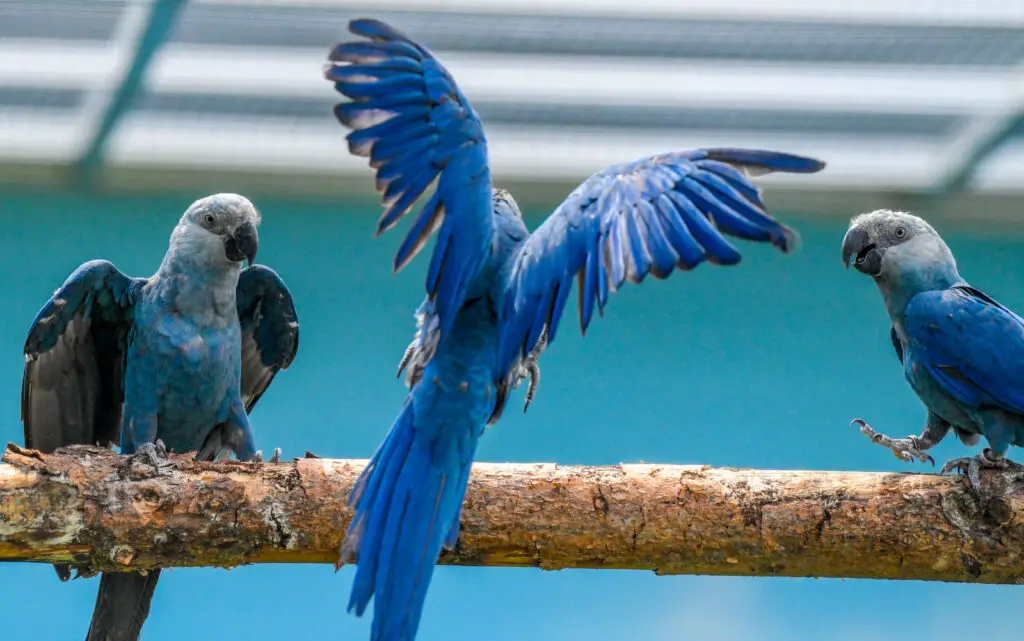
The species was first documented in the early 19th century by the German naturalist Johann Baptist von Spix, after whom it is named. Spix encountered the bird during his expedition to Brazil between 1817 and 1820. The macaw’s striking blue plumage and distinctive appearance immediately captivated the scientific community. The Spix’s Macaw remained elusive for many years, with sporadic sightings reported. The bird’s natural habitat is the caatinga, a unique and arid ecosystem in northeastern Brazil.
The decline was further exacerbated by illegal wildlife trade, with the Spix Macaw being highly sought after for its beauty and rarity. The macaws were captured and sold at exorbitant prices, primarily to collectors and private bird enthusiasts worldwide. By the late 20th century, the Spix’s Macaw was believed to have become extinct in the wild. However, a surviving population was discovered in the early 1990s in a remarkable turn of events. This small group of Spix’s Macaws was found in a remote region of Bahia, Brazil.
Today, the Spix’s Macaw remains one of the rarest and most endangered bird species. While significant progress has been made through breeding programs, challenges such as genetic diversity, habitat restoration, and ongoing illegal wildlife trade continue to threaten this magnificent species’ survival. The story of the Brazil Spix macaw serves as a powerful reminder for the importance of conservation efforts and the urgent need to protect and restore the natural habitats upon which endangered species depend.
Appearance
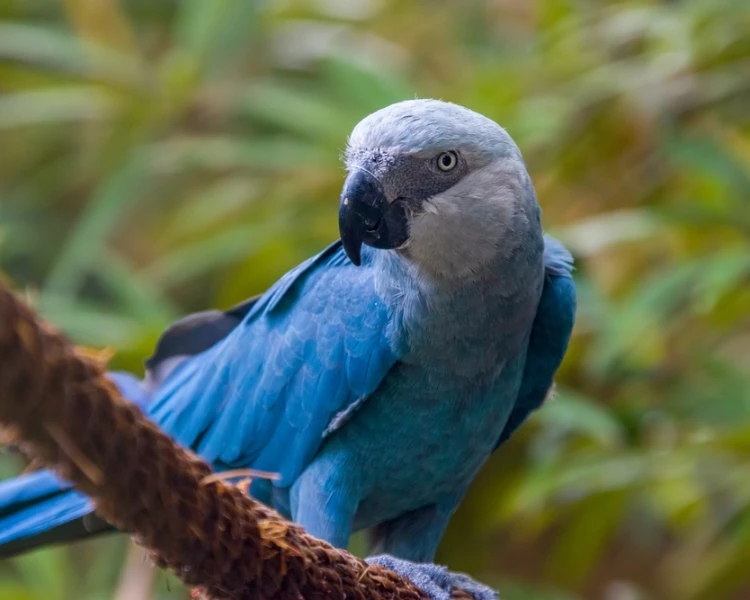
The Spix’s Macaw is a medium-sized parrot, measuring approximately 55 centimeters (22 inches) from the top of its head to the tip of its Spix macaw height, graceful tail. One of its most distinguishing characteristics is its vibrant blue plumage. The bird’s body is predominantly covered in a dazzling shade of deep blue, beautifully complemented by lighter shades of turquoise and teal on its wings and tail feathers. The feathers of the Spix Macaw are breathtakingly colorful and possess a velvety sheen, adding to its overall allure. The feathers on its head and neck are slightly lighter, often appearing as a silvery-blue hue.
In addition to its enchanting blue coloration, the Spix’s Macaw has a distinctive face. It features a large, curved beak that is pale gray. The beak is sturdy and designed for cracking open nuts and seeds, which form a significant part of its diet. The macaw’s eyes are a vibrant yellow, providing a vivid contrast against its blue feathers. Furthermore, the Spix Macaw possesses long, slender wings, allowing it to fly gracefully through its natural habitat. Its tail feathers are long and tapered, giving the bird exceptional maneuverability in flight.
These lighter feathers create a striking contrast against the intense blue of its body, enhancing its visual appeal. Overall, Spix’s Macaw is exquisite, showcasing a harmonious blend of brilliant blue hues, striking facial features, and graceful proportions. Its appearance truly exemplifies the wonders of the natural world, leaving an indelible impression on all fortunate enough to witness its beauty that what’s make it unique from all other different macaw parrot species.
Behavior
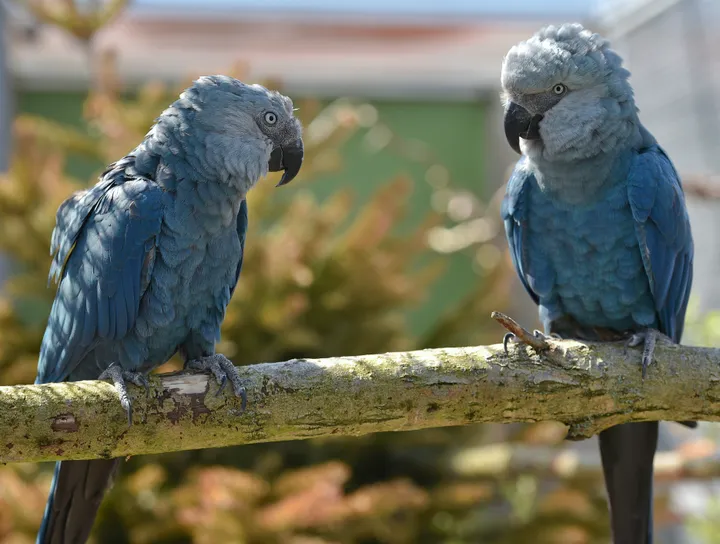
The behavior of the Spix Macaw is intriguing and showcases the intelligence and adaptability of this remarkable species. Here are some critical aspects of their behavior:
Social Interaction:
Spix Macaws are highly social birds and typically form strong bonds with their mates. They bond in pairs, often remaining with the same partner for life. These monogamous pairs exhibit affectionate behaviors, such as preening each other’s feathers and engaging in mutual grooming. They also communicate through vocalizations and body language within their social groups.
Vocalizations:
The Spix’s Macaw has a diverse range of calls and vocalizations. They use vocalizations to communicate with their flock members, signaling their presence, defending their territory, and maintaining social cohesion. Their calls vary from soft chirps and whistles to loud, raucous squawks.
Feeding Habits:
Spix Macaws primarily feed on various seeds, nuts, fruits, and berries. They have strong beaks that allow them to crack open tough shells to access the nutritious contents inside. These macaws are known to forage in small groups, using their keen eyesight and agile flight to locate and gather food sources.
Nesting Behavior:
Spix’s Macaws construct nests in tree cavities, usually in tall trees within their natural habitat. The female plays a significant role in nest preparation, while the male assists by providing materials such as twigs and leaves. The female’s lays a small clutch of eggs, usually two or three, and both parents take turns incubating them. After hatching, they raise their chicks together, sharing the responsibilities of feeding and protecting the young.
Intelligence:
Like many parrot species, Spix Macaws are known for their intelligence and problem-solving ability. They have been observed using tools, like sticks or branches, to extract food from hard-to-reach places. They can also learn and mimic various sounds, including human speech, making them highly trainable and popular as pets (although illegal due to their critically endangered status).
Flight and Movement:
Spix’s Macaws are agile and skilled flyers, using their long wings and tail feathers to soar. Spix macaw flying are capable of swift and precise flight, which allows them to navigate their native habitats with ease. Their flight patterns often include acrobatic displays, such as aerial loops and dives, particularly during courtship rituals.
Habitat
The Spix Macaw is native to a specific habitat within northeastern Brazil known as the caatinga. Within the caatinga, the Spix Macaw is found in areas with scattered palm trees, particularly the Licuri palm (Syagrus coronate). These palm trees provide essential resources for the macaws, including nesting sites and food sources. The macaws are highly dependent on the Licuri palm fruits, which comprise a significant portion of their diet.
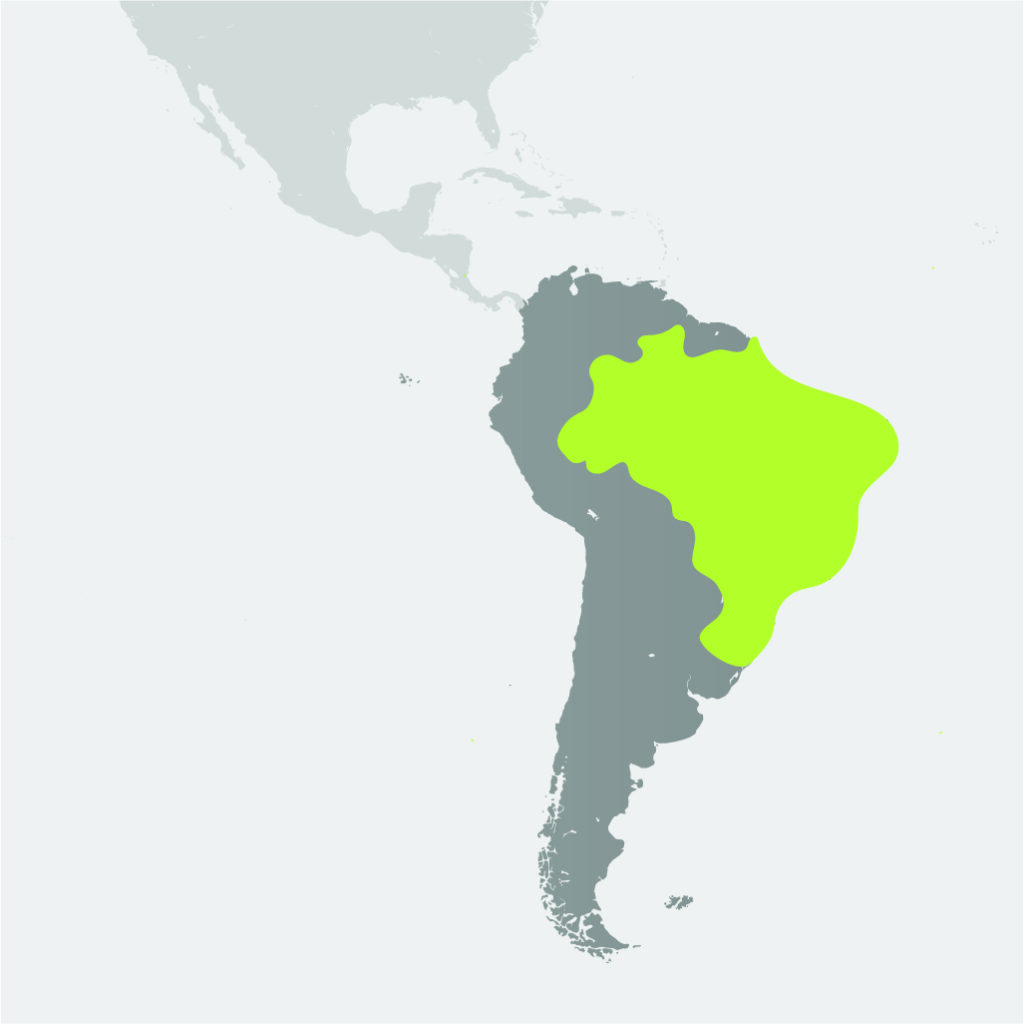
Historically, the Spix Macaw habitat a relatively small range within the caatinga, primarily in Bahia, Brazil. However, the macaw’s natural habitat has been dramatically reduced due to extensive habitat loss and fragmentation caused by agricultural expansion, logging, and human development. The remaining wild populations of Spix’s Macaw are now restricted to a few fragmented caatinga areas, making their conservation and protection even more crucial.
In addition to the macaw native habitat in the caatinga, the Spix Macaw is also found in captive breeding facilities worldwide, where conservation efforts are focused on increasing their numbers and eventually reintroducing them into suitable habitats in Brazil. Preserving and restoring the unique caatinga habitat is vital for the long-term survival of the Spix’s Macaw and other species that rely on this ecosystem.
Spix Macaw Diet
The Spix macaw diet primarily consists of various seeds, nuts, fruits, and berries. This species has adapted to feed on the resources available in its native caatinga habitat in northeastern Brazil. One of the critical food sources for the Spix’s Macaw is the fruit of the Licuri palm. The macaws rely heavily on these palm fruits, which are rich in nutrients and play a crucial role in their diet. Licuri palm fruits are high in fat content, providing essential energy for the macaws’ daily activities.
In addition to Licuri palm fruits, the Spix’s Macaw also consumes other palm fruits, such as those from the Carnauba palm (Copernicia prunifera) and the Babaçu palm (Attalea speciosa). These fruits contribute to the macaws’ nutritional needs and help diversify their diet. The Spix’s Macaw is known to forage in small groups, using their keen eyesight and agile flight to locate food sources. Depending on food availability, they can often be observed feeding in treetops or on the ground.
Besides fruits, the macaws also feed on seeds and nuts found in their habitat. They have strong beaks designed for cracking open tough shells, allowing them to access the nutritious contents inside. Seeds from various plants, such as legumes, grasses, and shrubs, comprise an important part of their diet. They have been observed feeding on succulent cacti, which provide hydration and supplementary nutrients. In captive breeding facilities, efforts are made to replicate their natural diet by providing a combination of fruits, seeds, nuts, and other appropriate food items.
Lifespan
The last Spix macaw lifespan is a subject of study and speculation due to its rarity and critically endangered status. While comprehensive data on the lifespan of wild Spix Macaws are limited, it is believed that they have the potential to live for several decades in suitable conditions. The lifespan can be extended in captivity, where the macaws are protected and provided with proper caring tips. Spix macaw captivity individuals have been known to live up to 30 to 40 years or more, with some reports suggesting even longer lifespans.
Factors influencing the lifespan of the Macaw include genetics, nutrition, environmental conditions, and access to appropriate veterinary care. Providing a well-balanced diet, a spacious and stimulating environment, and regular health check-ups can contribute to these birds’ overall health and longevity. It is important to note that the critical status of the Spix macaw population in the wild makes it even more challenging to determine their natural lifespan accurately.
The focus of conservation efforts is primarily on increasing their numbers through captive breeding and reintroduction programs and protecting and restoring their native habitat. Efforts are being made to ensure the survival and future of the Spix’s Macaw by addressing the threats they face and implementing conservation measures.
Population
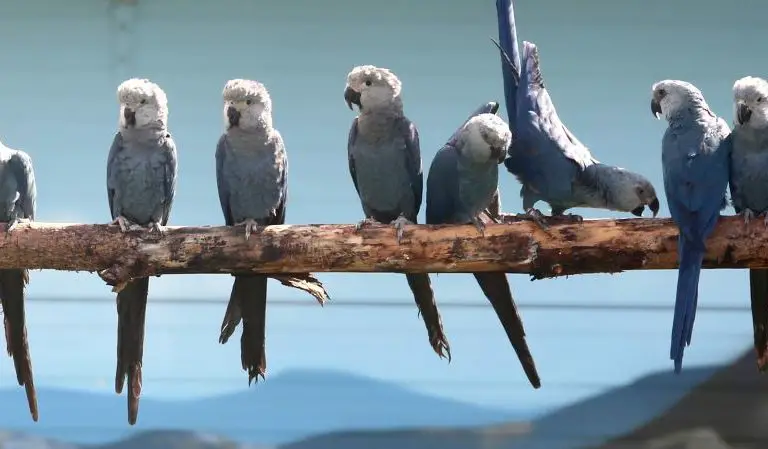
The population of the Spix Macaw (Cyanopsitta spixii) is critically low, making it one of the rarest bird species in the world. Due to extensive habitat loss and illegal wildlife trade, the wild population of Spix Macaw extinct dramatically over the years, reaching a point where it was believed to be extinct in the wild. However, efforts to conserve and reintroduce the species have established small populations in protected areas. Question: how many Spix macaw are left?
As of our knowledge cutoff in September 2021, the estimated global population of the Spix’s Macaw is around 170 individuals, with the majority residing in captivity. These individuals are part of carefully managed captive breeding programs in various facilities worldwide. These programs aim to increase the number of Spix Macaws, enhance genetic diversity, and eventually reintroduce them into their native habitat in northeastern Brazil and also solving Spix macaw reason for extinction.
While the captive Spix macaw population offers hope for the survival and recovery of the species, the small Spix macaw numbers of individuals remains a significant concern. It emphasizes the urgent need to continue conservation efforts, protect their natural habitat, and combat the illegal wildlife trade that constantly threatens their existence. Conservation organizations, governments, and dedicated individuals are working collaboratively to protect and rebuild the population of the Spix’s Macaw. Through intensive monitoring, habitat restoration, and public awareness, there is optimism for recovering this iconic species.
Global Price of Spix Macaw
The Spix’s Macaw is listed as critically endangered and protected under national and international laws, including CITIES. Due to its rarity and Spix macaw conservation status, legally acquiring a Spix Macaw for private ownership is virtually impossible. The species is highly protected, and any attempt to engage in the illegal wildlife trade of Spix’s Macaws can result in severe penalties, including fines and imprisonment. So everyone raises a question how much does a Spix macaw cost?
As for your answer, Suppose we estimate the cost of Spix Macaw. Even after every illegal aspect we have seen recently, the Spix macaw price is rounded around 200,000 USD, Which we convert and see as the Spix macaw parrot price in India. In that case, it figures about 1,64,19,500 (One Crore Sixty Four Lakh Nineteen Thousand Five Hundred), which is way above the more money you offer for a bird.
FAQs
What is the Spix’s Macaw?
The Spix Macaw, also remind as the little blue macaw, is a rare and critically endangered parrot species native to northeastern Brazil. It is known for its striking blue plumage and unique appearance.
Why is the Spix’s Macaw endangered?
The Spix Macaw is critically endangered primarily due to habitat loss and illegal wildlife trade. Deforestation, agricultural expansion, and human development have destroyed and fragmented its natural habitat. At the same time, the illegal capture and trade of these beautiful birds further threaten their survival.
How many Spix’s Macaws are left in the world?
As of our knowledge cutoff in September 2021, the estimated global population of the Spix Macaw is around 170 individuals, with the majority residing in captive breeding programs. The wild population was previously believed to be extinct, but efforts to reintroduce the species have established small populations in protected areas.
Can you have a Spix’s Macaw as a pet?
No, owning a Spix Macaw as a pet is illegal. The species is highly protected under national and international laws, including CITES. The focus is on conserving and restoring their populations in their natural habitat, not on private ownership.
Are there any successful breeding programs for the Spix’s Macaw?
There have been successful captive breeding programs for the Spix’s Macaw. These programs aim to increase the population, enhance genetic diversity, and provide a potential source for future reintroduction efforts. Collaboration between conservation organizations, governments, and experts is crucial in ensuring the success of these programs.
What is being done to protect the Spix’s Macaw?
Various conservation efforts are undergoing to protect the Spix’s Macaw. These include habitat restoration, captive breeding programs, anti-poaching measures, and international collaborations to combat illegal wildlife trade. Additionally, awareness campaigns and community engagement play a vital role in promoting conservation and supporting the species’ long-term survival.
Can the Spix’s Macaw be reintroduced into the wild?
Reintroduction efforts are being pursued for Spix’s Macaw. However, the process is complex and requires careful planning and preparation. Habitat restoration, reduction of threats, and establishing viable populations in protected areas are essential steps toward successful reintroduction.
Conclusion
The Spix Macaw represents a captivating and critically endangered species that has faced numerous challenges in its struggle for survival. The destruction of its natural habitat and illegal wildlife trade have pushed this iconic bird to the brink of extinction. However, through collaborative conservation efforts and captive breeding programs, there is a glimmer of hope for the future of the Spix’s Macaw. The dedication of conservation organizations, governments, and passionate individuals offers a ray of optimism. By restoring its habitat, combatting illegal trade, and raising awareness, we can work towards ensuring the Spix’s Macaw’s rightful place in the natural world, safeguarding its beauty and ecological significance for generations to come.

